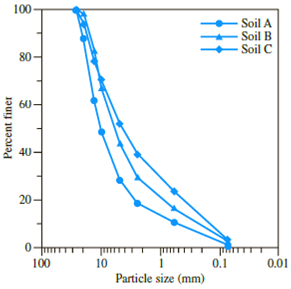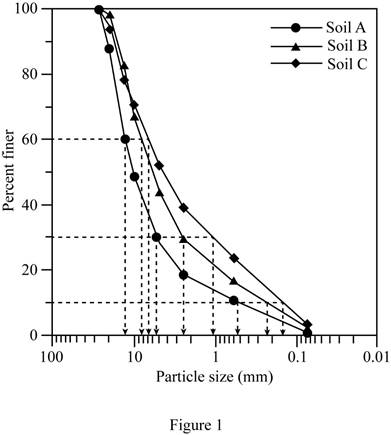
Three groups of students from the

(a)

(b)
Figure 2.35 (a) Soil-aggregate stockpile; (b) sieve analysis (Courtesy of Khaled Sobhan, Florida Atlantic University, Boca Raton, Florida)
a. Determine the coefficient of uniformity and the coefficient of gradation for Soils A, B, and C.
b. Which one is coarser: Soil A or Soil C? Justify your answer.
c. Although the soils are obtained from the same stockpile, why are the curves so different? (Hint: Comment on particle segregation and representative field sampling.)
d. Determine the percentages of gravel, sand and fines according to Unified Soil Classification System.
(a)
Calculate the coefficient of uniformity
Answer to Problem 2.1CTP
The uniformity coefficient of soil A is
The coefficient of gradation of soil A is
The uniformity coefficient of soil B is
The coefficient of gradation of soil B is
The uniformity coefficient of soil C is
The coefficient of gradation of soil C is
Explanation of Solution
Sketch the grain size distribution curve for soils A, B, and C as shown in Figure 1.

Refer to Figure 1.
For soil A:
The diameter of the particle corresponding to
The diameter of the particle corresponding to
The diameter of the particle corresponding to
For soil B:
The diameter of the particle corresponding to
The diameter of the particle corresponding to
The diameter of the particle corresponding to
For soil C:
The diameter of the particle corresponding to
The diameter of the particle corresponding to
The diameter of the particle corresponding to
Calculate the uniformity coefficient
For soil A:
Substitute
Hence, the uniformity coefficient for soil A is
For soil B:
Substitute
Hence, the uniformity coefficient for soil B is
For soil C:
Substitute
Hence, the uniformity coefficient for soil C is
Calculate the coefficient of gradation
For soil A:
Substitute
Hence, the coefficient of gradation for soil A is
For soil B:
Substitute
Hence, the coefficient of gradation for soil B is
For soil C:
Substitute
Therefore, the coefficient of gradation for soil C is
(b)
State which of the soil is coarser from soil A and C.
Answer to Problem 2.1CTP
Soil A is coarser than soil C.
Explanation of Solution
Refer to part (a).
The uniformity coefficient of soil A is
The uniformity coefficient of soil C is
The percent of soil finer than
The percent of soil finer than
Hence, a higher percentage of soil C is finer than soil A.
Hence, soil A is coarser than soil C.
(c)
Explain the reason for curve different of soil A, B and C if it is obtained from same stockpile.
Explanation of Solution
The particle-size distribution curve shows the range of particle sizes present in a soil and the type of distribution of various-size particles.
Refer to Figure 1.
Particle separation of coarser and finer particles may take place in aggregate stockpiles. This makes representative sampling difficult.
Therefore, the particle-size distribution curve is different for soils A, B, and C.
(d)
Calculate the percentages of gravel, sand, and fines according to the Unified Soil Classification System.
Answer to Problem 2.1CTP
The percentage of gravel for soil A is
The percentage of sand for soil A is
The percentage of fines for soil A is
The percentage of gravel for soil B is
The percentage of sand for soil B is
The percentage of fines for soil B is
The percentage of gravel for soil C is
The percentage of sand for soil C is
The percentage of fines for soil C is
Explanation of Solution
Refer to Figure 1.
For soil A.
The percent passing through
The percent passing through
Calculate the percentage of gravel as shown below.
Hence, the percentage of gravel is
Calculate the percentage of sand as shown below.
Hence, the percentage of sand is
Calculate the percentage of fines as shown below.
Hence, the percentage of fines is
Refer to Figure 1.
For soil B.
The percent passing through
The percent passing through
Calculate the percentage of gravel as shown below.
Hence, the percentage of gravel is
Calculate the percentage of sand as shown below.
Hence, the percentage of sand is
Calculate the percentage of fines as shown below.
Hence, the percentage of fines is
Refer to Figure 1.
For soil C.
The percent passing through
The percent passing through
Calculate the percentage of gravel as shown below.
Hence, the percentage of gravel is
Calculate the percentage of sand as shown below.
Hence, the percentage of sand is
Calculate the percentage of fines as shown below.
Hence, the percentage of fines is
Want to see more full solutions like this?
Chapter 2 Solutions
PRIN.OF GEOTECHNICAL...-MINDTAP(2 SEM)
- B: Find the area of the region in the first quadrant that is within the cardioid r=1-cos 0 1-cos e TT/2 0arrow_forwardPlease do not use any AI tools to solve this question. I need a fully manual, step-by-step solution with clear explanations, as if it were done by a human tutor. No AI-generated responses, please.arrow_forwardPseudomonas putida is being used to biodegrade toluene in an in-situ, aerobic bioremediation system. The environmental conditions are oligotrophic, in that Pseudomonas is starved for other nutrients and organic carbon/energy sources, including toluene, which is present at low concentrations (S0 = 5 mg/L). It is able to perform oxidative phosphorylation using toluene as an electron donor to obtain ATP as a primary energy source that primarily fuels its biosynthesis pathways (i.e., fs ~ 1). During this oxidation process, toluene is degraded to a less harmful metabolite, benzoic acid. a) Given this information write out the kinetic model to describe the substrate degradation profile as a function of time. b) With the information in the Table below, compute the substrate (S) and biomass concentrations (X) after 3.5 days have elapsed. Assume that the initial degrading population is quite low, given the oligotrophic conditions (X0 = 0.5 mg/L). Biokinetic Model Parameter μmax Ks Y Kd Value…arrow_forward
- A pure bacterial culture is growing in a warm, oxygenated, and nutrient rich solution present in a batch reactor system. Given what you know about doubling times: a) Estimate the specific growth rate of this culture if the generation time is determined to be 40 minutes. b) If 60 cells are present initially, calculate the mass of cells present after a 16-hour period. Assume that the biomass weighs 5.7E-10 mg/cell.arrow_forwardHow do different urban structures influence a city’s economic health over time? Provide an example of a structure that strengthened or weakened a city.arrow_forward*688* -2.625- —1.250- (d) 1. It is double dimensioned. 2. The extension lines are too long. 3. It has a dimension to a hidden line. 4. The dimensions are on the part.arrow_forward
- Consider the soil profile below: 3m Vary 18.3kN/m Sand Groundwater table 6m -19.8kN/m² 4m Clay Sand Calculate the effective stress at the location of the red star (4m inside clay layer) if the saturated unit weight of the clay is 21.8 kN/m^3 Note: give your answer in units of kPa A sample of the clay layer in the previous problem is extracted from the location of the red star and tested in the lab. Vertical strain, &, (%) 1 50 40 10 100 1000 Effective consolidation stress, σ (kPa) Odometer testing yielded the following consolidation curve (red line): Calculate the over-consolidation ratio of the clay sample. Use two decimal places.arrow_forwardNote: this question is part of soil mechanics Submit a neat, step-by-step handwritten solution that is fully worked out manually without any AI involvement. The solution must be expert-level, with all steps simplified and clearly shown. I will evaluate it based on precision and completeness, using the attached image as a reference. Ensure every part is thoroughly checked for accuracy before submission. Thank you.arrow_forwardNote: the two questions are connected as parts so please answer soil mechanics question as best you can !. Provide a clear, step-by-step simplified handwritten solution (with no extra explanations) that is entirely produced by hand without any AI help. I require an expert-level answer, and I will assess it based on the quality and accuracy of the work, referring to the attached image for additional guidance. Make sure every detail is carefully verified for correctness before you submit. Thanks!.arrow_forward
 Principles of Geotechnical Engineering (MindTap C...Civil EngineeringISBN:9781305970939Author:Braja M. Das, Khaled SobhanPublisher:Cengage Learning
Principles of Geotechnical Engineering (MindTap C...Civil EngineeringISBN:9781305970939Author:Braja M. Das, Khaled SobhanPublisher:Cengage Learning Traffic and Highway EngineeringCivil EngineeringISBN:9781305156241Author:Garber, Nicholas J.Publisher:Cengage Learning
Traffic and Highway EngineeringCivil EngineeringISBN:9781305156241Author:Garber, Nicholas J.Publisher:Cengage Learning Fundamentals of Geotechnical Engineering (MindTap...Civil EngineeringISBN:9781305635180Author:Braja M. Das, Nagaratnam SivakuganPublisher:Cengage Learning
Fundamentals of Geotechnical Engineering (MindTap...Civil EngineeringISBN:9781305635180Author:Braja M. Das, Nagaratnam SivakuganPublisher:Cengage Learning Construction Materials, Methods and Techniques (M...Civil EngineeringISBN:9781305086272Author:William P. Spence, Eva KultermannPublisher:Cengage Learning
Construction Materials, Methods and Techniques (M...Civil EngineeringISBN:9781305086272Author:William P. Spence, Eva KultermannPublisher:Cengage Learning Principles of Foundation Engineering (MindTap Cou...Civil EngineeringISBN:9781337705028Author:Braja M. Das, Nagaratnam SivakuganPublisher:Cengage Learning
Principles of Foundation Engineering (MindTap Cou...Civil EngineeringISBN:9781337705028Author:Braja M. Das, Nagaratnam SivakuganPublisher:Cengage Learning




